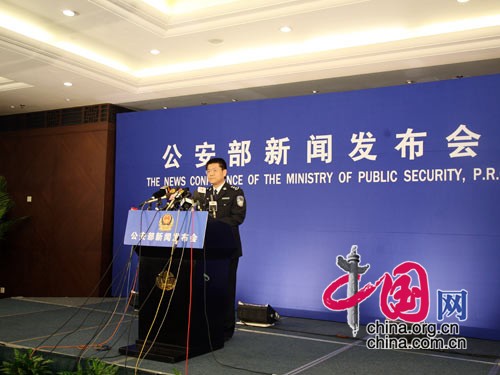
China's Ministry of Public Security said on Tuesday that it had gathered sufficient evidence showing that March 14 riots in Lhasa was not isolated or accidental but was part of the "Tibetan People's Uprising Movement" plotted by the Dalai clique.[Full coverage] [ Videos]
Videos]
Solid facts showed that the unrest in Lhasa, the capital of southwest China's Tibet Autonomous Region, was organized, premeditated, masterminded and instigated by the Dalai clique and its "Tibet independence" forces, the ministry said.
"No matter what disguise they use, the irrefutable facts cannot be changed," it said.
HOW THE "MOVEMENT" STARTED
Beijing will host the 29th Summer Olympic Games in 2008, which also marks the 30th anniversary of China's reform and opening-up.
The international sporting event has drawn worldwide attention, including from the Dalai clique, which has been in exile for more than 40 years, the ministry said.
The Dalai clique believed that this would be "the last chance" for them and decided to launch the "Tibetan People's Uprising Movement" within and outside China, attempting to "create a crisis in China through awakening and coordinating the maneuver in Tibet, " the ministry said.
The ministry listed a series of recent events that showed the actions that the Dalai clique had taken to support the "Tibetan People's Uprising Movement":
-- In May 2007, the clique held the "Fifth International Conference of Tibet Support Groups" in Brussels, which Samdhong, the "prime minister" of the "Tibetan government-in-exile", attended. The clique passed an "strategic plan" at the conference and decided to launch activities opposing the Beijing Olympics.
-- Subsequently, the "Tibet independence" forces in the United States proposed the idea of the "Tibetan People's Uprising Movement." Senior officials of the Dalai clique studied and approved the plan. They believed that 2008 would be their last chance to achieve "Tibet independence" and decided to use the "favorable opportunity" before the Olympics to stage sabotage activities in the Tibetan-inhabited areas in China.
-- Late last year, several "Tibetan independence" secessionist organizations, including the "Tibetan Youth Congress," the "Tibetan Women's Association" and "Students for a Free Tibet", met in India, where they agreed on the demands to be made to the Chinese government .
These included: "The Dalai Lama should be allowed to return to Tibet, all Chinese should leave Tibet and release all the political prisoners."
They said that if the Chinese government failed to meet their demands, they would launch the "Tibetan People's Uprising Movement" within and outside China, and they would also set up a contact network between Tibetans in exile and Tibetans in China to stage coordinated activities in China.
-- On Jan. 4 and 25, seven "Tibet independence" organizations, including the "Tibetan Youth Congress," the "Tibetan Women's Association," "Students for a Free Tibet," the "Gu-Chu-Sum Movement of Tibet," the "National Democratic Party of Tibet," the "International Tibet Support Network" and the "Tibetan Writers Organization," held press conferences in New Delhi, where they issued the so-called "Declaration of Tibetan People's Uprising Movement" and then posted it on the Internet.
In the so-called "declaration," they turned a blind eye to the fact that Tibet has since ancient times been a part of the Chinese territory, claiming that "Tibet and China are two different countries" and "China is not qualified to host the Olympic Games without resolving the Tibet issue".
They also announced that they would launch a massive, ongoing "Tibetan People's Uprising Movement" from March 10, in an attempt to make it the "great turning point in the history of Tibet's fight for freedom."
To implement the "Tibetan People's Uprising Movement," the "Tibetan Youth Congress" and other "Tibet independence" organizations held two training classes on how to carry out violent, terrorist activities.
-- From Feb. 3-10, the Dalai Lama attended religious activities in a temple in India and fanned sentiment among the believers by claiming that "although the Tibetan people are under the rule of the Communist Party of China, their hearts are on the other side."
The Dalai clique drew up an "action plan" for the "Tibetan People's Uprising Movement": starting the "Peaceful March to Tibet" overseas from March 10; asking Tibetans around the world, including those in Tibet, to take to the streets on March 10; launching such activities as a "Freedom Torch Relay," "Global Torch Relay" and "Global Action Day"; organizing violent attacks on various Chinese embassies and staging hunger strikes and massive protests.
"The 'Tibetan People's Uprising Movement' plotted by the Dalai clique is intended to sabotage the peaceful, stable and unified social situation in China and use the Olympic Games to put pressure on the Chinese government, thus achieving their political aims," a spokesman with the Ministry of Public Security said.
"The word 'uprising' means to overthrow the present regime through armed force and violence. So I'm wondering, is there any country that allows such an 'uprising' against the central government? Is there any country that tolerates such activities wantonly instigating the subversion of a state regime?" he said.
DALAI CLIQUE'S UNDENIABLE TIES WITH THE RIOTS
"Tibet independence" forces have carried out a series of activities directed and masterminded by the Dalai clique since March 10.
On March 10, the Dalai clique held a rally in Dharamsala, India to commemorate the anniversary of the so-called "Tibet uprising" in 1959. Dalai, Samdhong and other important figures in the clique spoke at the rally.